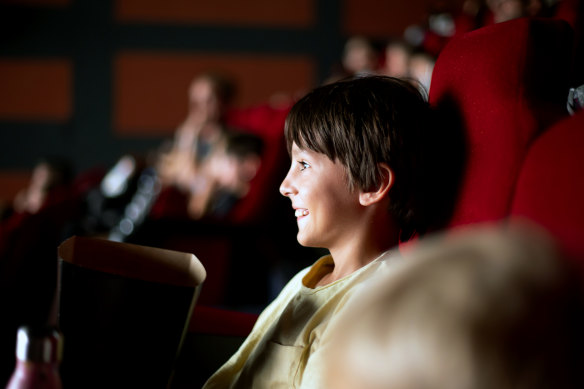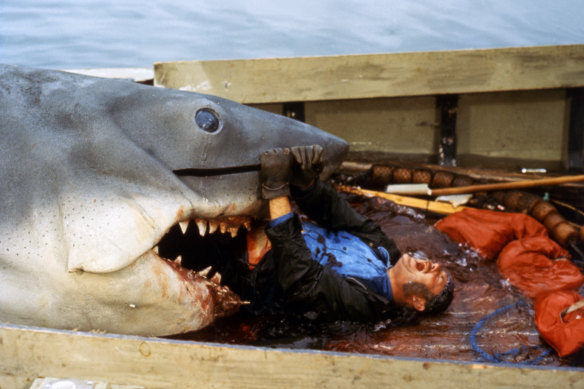I let my kids watch horror movies. Have I scarred them for life?
Upon hearing the first note of John Williams’ iconic and foreboding score, I turned from the screen to tentatively observe my two daughters’ reactions as they witnessed the first attack of Bruce, the notorious man-hunting shark of Jaws.
But rather than screams of horror or comments about being too afraid to ever swim in the ocean again, my children, aged nine and 10, responded with, “Is that it?”

Experts say research is important when it comes to deciding what films are appropriate for children.Credit: iStock
As a horror movie fan, it seems my bloodthirsty entertainment gene had been passed down to my kin, who after reading and watching anything labelled “scary” within their age range – from Goosebumps to Are You Afraid of the Dark? – started asking my husband and me for permission to watch “a real horror movie”.
So, after months of pleading, nagging and begging, we succumbed, allowing them to watch the M-rated, 1975 shark classic.
But as responsible and loving parents, of course, we had reservations. While we wanted to avoid quashing their interests, or be a hurdle in what is a rite of passage of growing up, as caregivers, we also didn’t want to scar them for life.
With this in mind, as they watched the film, and in the weeks following, we kept a close eye on our daughters for any signs they may have been adversely affected by the admittedly, now very outdated shark attack special effects.
Not only did we find they were untainted by the experience, we also noticed they developed quite the penchant for shark horror with follow-up requests to watch the 2018 shark action film The Meg and its soon-to-be-released sequel Meg 2.
While I can’t judge them for their entertainment tastes (because I share them) I do wonder, as a parent, how scary is too scary?
A simple approach would be to strictly follow the Australian film classification guidelines and only allow my kids to view G- and PG-rated films. But even this isn’t a straightforward decision because, while there are legal restrictions around films with MA 15+, R 18+ and X 18+ ratings, films rated M are left to the discretion of parents and guardians.
However, according to experts, there are ways for parents to navigate beyond the classifications, while also protecting children from inappropriate or potentially harmful content. Derek McCormack, director of the Raising Children Network, believes it all comes down to research.

Actor Robert Shaw on the set of ‘Jaws’.Credit: Getty Images
Parents can help make decisions around particular films by utilising online movie reviews from raisingchildren.net.au or Common Sense Media for in-depth information about the content, messages and characters in a movie they are considering for their children.
“The reviewers have expertise in child development and their reviews alert parents to themes or events to watch out for, as well as including suggestions for things to talk with their children about after watching the film,” McCormack says.
But as all parents know, kids won’t always ask before watching a movie. So, what happens if your pre-teen has watched a horror title without your permission? Should you be concerned? Well, depending on the specific content of the film and your child, the answer may be yes.
“When children – and adults for that matter – see something that evokes an emotional response, such as fear, horror or shock, it can repeatedly play back in their head, where they can recall and visualise the images and/or sounds that have traumatised them,” says Dr Lesley-Anne Ey, a senior lecturer in Education Futures at the University of South Australia.
In the case of a film like It, this could manifest with a fear of clowns, drains, showers and toilets, which can then lead to issues around hygiene, with avoidance of showering, or even toileting, says child psychologist and co-founder of Quirky Kids, Dr Kimberley O’Brien.
“If a child is afraid, they may [also] begin showing changes in behaviour, such as bed wetting, may show signs of separation anxiety, or be affected physically, for example, by becoming quite jumpy,” she says.
One of the main reasons pre-teen children can experience anxiety after watching a scary content is because of their inability to differentiate between what is real and what is not.
“Kids don’t often realise that a movie is make-believe – that it is make-up and costumes – so looking at the behind-the-scenes features of how the movie is made can be helpful if a child is showing any adverse effects of watching a certain film,” O’Brien says.
But the news is not all horrific (pun intended), because while some children may find the material of horror films unsettling, other kids (like mine) don’t. It’s this parental knowledge, along with research and classification advice, that is critical in deciding on whether a scary film is suitable for kids, regardless of their age.
“Ultimately parents should preview the film with their child in mind to identify whether they’re capable of understanding the content and whether the content may have a negative impact,” says Ey.
In the case of The Meg, while I don’t think a CGI Megalodon will cause my two daughters to be wary of jumping into the ocean this summer, Common Sense Media does recommend viewing for ages 14 and above. With that in mind, I may press pause on our cinema plans.
Make the most of your health, relationships, fitness and nutrition with our Live Well newsletter. Get it in your inbox every Monday.